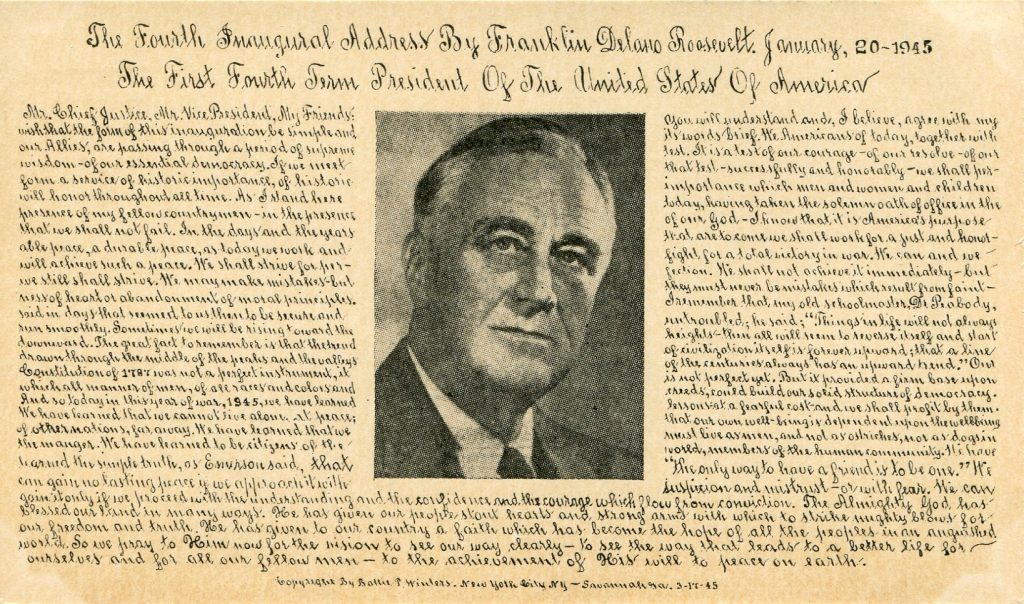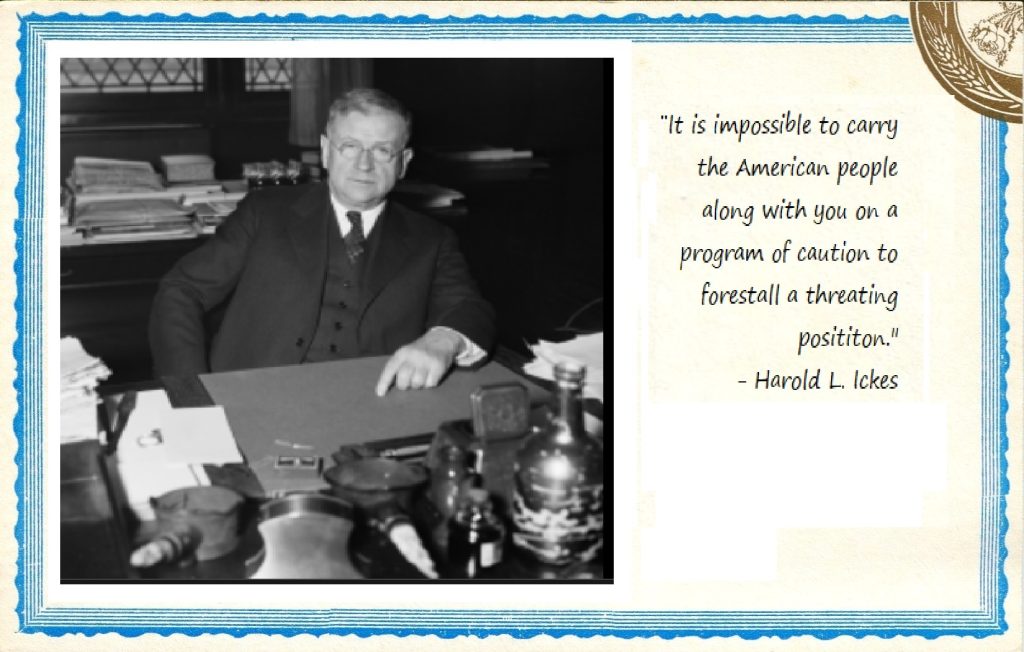Eleanor “Ellie” McCrackin
Two from the President’s Cabinet
1933 to 1945
In one way or another we are all Presidential Historians. When a social life was still part of a routine existence, one of the favorite parlor games played was “Name the President!” There were at least three variations and to win you needed a well-honed memory.
Franklin Delano Roosevelt was the White House resident in 1944. On November 7, FDR defeated fellow New Yorker, Thomas E. Dewey, to win his fourth term in office. There had never been a president who ran for a third term and the idea of winning a fourth term was unthinkable, but economic, social and world circumstances demanded that FDR remain as president.
One of the most fascinating duties of a President-Elect is the selection of the men and women he picks to be members of the President’s Cabinet. The Cabinet is a cadre of individuals that includes the vice president and those who the president-elect chooses to head the various departments in the executive branch of our federal government. They are in fact the official advisory body to the president; however, most members are subject to Senate confirmation.
The first cabinet was formed in March 1789. When Roosevelt’s fourth term began on January 20, 1945, the cabinet consisted of Vice President, Harry S. Truman and ten others who would serve at the pleasure of the president. On that day Vice President Truman was the only new member of the cabinet.

Through the years, since 1933 when FDR took office for his first term only 28 individuals had served in the cabinet. Eight of the departments had seen at least two secretaries in those years; but two departments were led by just one person, and each was willing to continue into Roosevelt’s fourth term: Harold L. Ickes, Secretary of the Interior and Frances Perkins, Secretary of Labor.

Harold LeClair Ickes was born in Pennsylvania but after the death of his mother when he was 13, the family moved to Illinois where he attended high school in Chicago. After high school he earned a bachelor-of-arts degree from the University of Chicago in 1897. He worked as a newspaper reporter while he studied to obtain a law degree that he completed in 1907 but rarely used. (For some interesting history search the Internet for the case of Lazarus Averbuch. The Averbuch murder was Harold Ickes’s first case.)
From 1917 to 1918 he served with the YMCA in France when it was stationed with the 35th Infantry Division of the American Expeditionary Forces.
Ickes was long associated with political reform groups, mostly within the Republican party. He was most interested in reforms needed in Chicago, but in 1932 when Roosevelt was elected the President-Elect’s advisors suggested that a progressive Republican would be a good choice. Ickes was Roosevelt’s second choice, but Ickes served the president well and for the most part was responsible for implementation of Roosevelt’s New Deal.
[One fact that went unmentioned in Postcard History’s recent article on Large Letter Dam postcards was that Secretary Harold Ickes offered the official government address at the dedication of Boulder Dam.]
Ickes died in February 1952 but his place in history was guaranteed when other of his accomplishments were made known after his death, i.e., the implementation of major relief programs at the Public Works Administration and environmental efforts he administered during the Depression. One surprising fact about Harold Ickes was that he had been the president of the Chicago NAACP and was determined to eliminate segregation in all areas of the government over which he had control. His 13 years as Secretary of the Interior earned him the title of the second longest-serving cabinet member in U. S. history.

Frances Perkins, served in FDR’s cabinet along with her colleague Harold Ickes for the full length of the Roosevelt administration. That service entitled her to the honor of being the longest serving Secretary of Labor in U. S. history. Ms. Perkins was the first female cabinet member.
Born in 1880 into a prominent Massachusetts family that could trace its roots back to the colonial era, Fannie Perkins earned a diploma at the Classical High School in Worcester, and in 1902 completed a bachelor’s degree in chemistry at Mount Holyoke College.
Although unrelated to her core curricula while at college Perkins developed a keen interest in progressive politics and the suffrage movement. In spite of her extra-curricular activities and her rigorous course work she also served as class president. The noted Annah May Soule was among the professors who influenced Perkins when she assigned students to pay visits to New England factories to observe the often-dreadful working conditions.
After college Fannie taught chemistry in Illinois and volunteered at the settlement houses where she met and worked with Jane Addams, the American social worker and women’s suffrage pioneer. In 1905 Fannie joined the Episcopal church, changed her name to Frances and in 1907 moved to Philadelphia. She enrolled in the University of Pennsylvania to study economics.
Frances continued her economic studies at Columbia and in 1910 she witnessed the Triangle Shirtwaist Factory Fire in lower Manhattan. It was a pivotal event that changed her life forever; more so than her marriage and the birth of her daughter.
Perkins’s story continues in the history books. In 1933, Roosevelt summoned Perkins to ask her to join his cabinet. Perkins presented Roosevelt with a list of labor programs for which she would fight, from Social Security to minimum wage. “Nothing like this has ever been done in the United States before,” she told Roosevelt. “You know that don’t you?” Roosevelt knew she was right and agreed to back her, then nominated her as Secretary of Labor.
Frances Perkins served with distinction and the fact is emphasized in a 2009 history entitled, The Woman Behind the New Deal by Kirstin Downey. “Perkins … not only had to do more than her male counterparts to prove herself, but she had to do it while dealing with rough-and-tumble labor leaders, a husband in and out of mental institutions, condescending bureaucrats, and some Congress members hell-bent on impeaching her.”
* * *
Frances Perkins was the first woman to serve in the American President’s cabinet, since then thirty-nine women have served in cabinet level positions. Of the 39, 16 have served in Republican administrations, 23 in Democrat administrations. Currently, President Biden has five women in his cabinet, two less than former President Obama who appointed seven. Other presidents who appointed women to cabinet level positions were: Truman, who kept Perkins on in his cabinet and Ford, 1; Trump, 2; Reagan and Bush (41) 3; Carter, 4; Clinton and G.W. Bush, 5. There were no women in the Eisenhower, Kennedy, Johnson, or Nixon administrations.
After her marriage to Paul Wilson, Perkins fought in court to retain her maiden name so that her political activities would be less likely to affect the career of her economist husband. Clearly a woman ahead of her time!
Lots of interesting facts about FDR and his cabinet. Thanks Ellie. Nicely written.